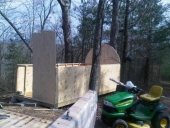
 7
7




 1
1




 9
9




My suburban building and homesteading blog https://offgridburbia.com/
 2
2




The holy trinity of wholesomeness: Fred Rogers - be kind to others; Steve Irwin - be kind to animals; Bob Ross - be kind to yourself
 1
1




 1
1




Jason Nault, Washington, USA
Check out my rainwater catch and automated garden build at https://permies.com/t/168563/Building-rainwater-catch-system-irrigation
 2
2




Country oriented nerd with primary interests in alternate energy in particular solar. Dabble in gardening, trees, cob, soil building and a host of others.
 2
2




Living a life that requires no vacation.
 1
1




John Daley Bendigo, Australia The Enemy of progress is the hope of a perfect plan
Benefits of rainfall collection https://permies.com/t/88043/benefits-rainfall-collection
GOOD DEBT/ BAD DEBT https://permies.com/t/179218/mortgages-good-debt-bad-debt




Stacy Witscher wrote:I agree with Jason Nault. 3000 gallons is unlikely to handle all of your families needs through the west coast dry period if you are relying on this for all of your water needs. Are you urban/suburban or rural? We are interested in adding more rainwater collection because well water isn't permitted for irrigation purposes except a small 1/2 acre amount and not at all for commercial purposes. At little more information might be useful. Generally speaking to store water costs about $1 a gallon.
Jason Nault, Washington, USA
Check out my rainwater catch and automated garden build at https://permies.com/t/168563/Building-rainwater-catch-system-irrigation




Fish heads fish heads roly poly fish heads




Dan Fish wrote:I need more storage. What is the cheapest route I can go to store about 6000 gallons? It would have to be above ground or at best extending 3-4 feet below grade. Is the answer just big plastic tanks?
I just figured while we are all here....
Jason Nault, Washington, USA
Check out my rainwater catch and automated garden build at https://permies.com/t/168563/Building-rainwater-catch-system-irrigation




John Daley Bendigo, Australia The Enemy of progress is the hope of a perfect plan
Benefits of rainfall collection https://permies.com/t/88043/benefits-rainfall-collection
GOOD DEBT/ BAD DEBT https://permies.com/t/179218/mortgages-good-debt-bad-debt

|
If a tomato is a fruit, does that mean ketchup is a smoothie? What if we mix in a tiny ad?
Freaky Cheap Heat - 2 hour movie - HD streaming
https://permies.com/wiki/238453/Freaky-Cheap-Heat-hour-movie
|





